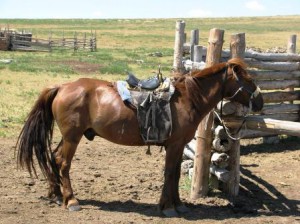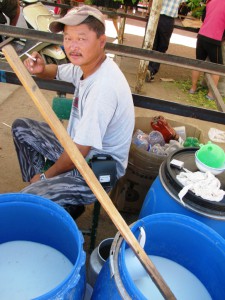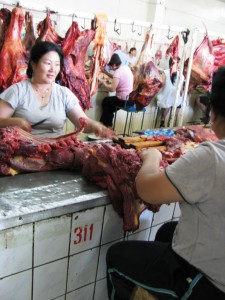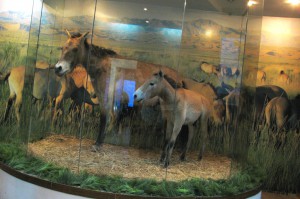- How to identify small grains.
- Can you identify a garlic?
- “You can’t expect a starving person to save a tree.” I s’pose not. But is that any reason to endow a chair in conflict resolution and development?
- “A farmer needs to let the garden get wild in order to protect it from the wild.” Course she does.
- Sorghum a huge success in Kitui, Kenya.
- Field trip to a grower of old grain varieties.
- New cowpea varieties selling like hotcakes, FARA told. And the old cowpeas?
Looking for leimotifs in the early history of wheat and rice
![]() There are two papers out just now which review in detail archaeobotanical and genetic data to elucidate the early history of crops. Dorian Fuller and numerous co-authors do it for Asian rice (Oryza sativa) 1, Hakan Özkan and others do it for emmer wheat (Triticum dicoccoides). 2 And Fuller actually also comments on the emmer paper on his blog. 3
There are two papers out just now which review in detail archaeobotanical and genetic data to elucidate the early history of crops. Dorian Fuller and numerous co-authors do it for Asian rice (Oryza sativa) 1, Hakan Özkan and others do it for emmer wheat (Triticum dicoccoides). 2 And Fuller actually also comments on the emmer paper on his blog. 3
In such situations, my first instinct is to look for commonalities, rather than get lost in the specifics. 4 Certainly, the occasional difficulty of reconciling archaeobotanical and genetic data comes up in both reviews. Actually there’s a third paper out which looks at that too, suggesting that “genetic and archaeological studies represent complementary perspectives on domestication, each highlighting a different facet of this complex problem.” 5 Complexity is a word that recurs a lot, in fact. Here’s Fuller: “Asian rices have had a complex history.” And here’s Özkan: “The spread of domestic emmer would have been extremely complex…”
But the really interesting question to me is whether there are similarities within the complexity. As Tolstoy might have asked, are the early histories of different crops complex each after their own fashion? Fuller summarizes the emmer story as one of “multiple starts of cultivation, gradual domestication, but the possible predominance of one domesticated line at the end of the process,” and there certainly are some echoes of that in rice. But I want to focus on one little series of events or processes that occurs in both rice and emmer, in each case with its peculiarities, but nevertheless comparable.
Cultivated emmer (Triticum dicoccon) was developed from its wild progenitor (T. dicoccoides) in south-eastern Turkey. 6 It then spread to the north-east, where it came into contact with wild Aegilops tauschii. Somewhere in the corridor between Armenia and the Caspian Sea, hybridization between the two gave rise to hexaploid bread wheat from tetraploid emmer. Well, something kind of similar also happened in rice. Fuller’s paper has a nice diagram summarizing the relationship between japonica and indica rices. Simplifying wildly, japonica arose in China from wild Oryza rufipogon. It was then taken to India, where it came into contact with cultivated proto-indica rices and also the wild species from which that was derived (O. nirvana). Hybridization and back-crossing eventually led to fully indica varieties. A crop develops in one place, then moves somewhere else, where it interacts with something, leading to the development of a somewhat different crop.
Now, I’m not sure whether the differences in this process, in particular the fact that polyploidy was involved in the emmer case but not rice, are more important than the similarities. But I wonder if the domestication and spread of crops can perhaps be broken down into a series of similar tropes, or maybe leitmotifs, I’m not sure what one would call them. At the very least it might help people like me make sense of — and try to remember, and keep straight — the complexities.
The horse in Mongolian culture
 They may be trying to develop and diversify their agriculture now (well, since the 1950s), but Mongolians are traditionally very much a nomadic herding culture, with the horse at its centre. 7 One expression of that is how early kids learn to ride.
They may be trying to develop and diversify their agriculture now (well, since the 1950s), but Mongolians are traditionally very much a nomadic herding culture, with the horse at its centre. 7 One expression of that is how early kids learn to ride.
Most young Mongolians — boys in particular — learn to ride from a very young age. They will then help their fathers with the herding of goats, sheep and horses. Some children have a chance to ride at festivals called Naadam — the biggest of which is held on 11th-13th July in Ulaanbaatar — though there are naadams held throughout the year all over the countryside. Young jockeys between the age of 5 and 12 (girls and boys) race horses over distances ranging from 15km to 30km. There are 6 categories for the races depending on the horses’ age, including a category for 1 year old horses (daag) and one for stallions (azarag).


Alas, this museum display is as close as I got to seeing the famous Mongolian Wild Horse or Przewalski’s Horse (Equus ferus przewalskii), locally known as takhi.
It’s possibly the “closest living wild relative of the domesticated horse, Equus caballus.” Certainly it is genetically very close to the local domesticated breed based on molecular markers, though that could be because of interbreeding. Last seen in the wild in 1969, its restoration in China and Mongolia from captive stock, for example to the Hustain Nuruu National Conservation Park, is one of the great conservation success stories.
Unbottling the lentil
![]() It is well known that crops go through a genetic bottleneck at domestication. Due to the founder effect, they typically show a fraction of the genetic diversity found in their wild relatives. Which is bad, but fixable: fixing it is the plant breeder’s job — or part of it anyway. What’s less well known, according to a recent paper on lentils by Willy Erskine and co-authors in GRACE, is that the movement of a crop around the world can also often lead to bottlenecks. 8
It is well known that crops go through a genetic bottleneck at domestication. Due to the founder effect, they typically show a fraction of the genetic diversity found in their wild relatives. Which is bad, but fixable: fixing it is the plant breeder’s job — or part of it anyway. What’s less well known, according to a recent paper on lentils by Willy Erskine and co-authors in GRACE, is that the movement of a crop around the world can also often lead to bottlenecks. 8
Lentil cultivation moved from Afghanistan into the Indo-Gangetic Plain sometime between 7000 and 4000 BC. The authors “reconstructed” this movement by growing random subsets of the ICARDA world lentil collection at two sites, Islamabad and Faisalabad, in Pakistan. Faisalabad is typical of conditions in the Plain, Islamabad is a transitional, mid-altitude environment.
They found that most Afghani accessions did not flower in Islamabad before the local material matured, due to a combination of temperature and photoperiod, the main determinants of flowering in lentils. The few that did were among the most late-flowering in the world. This is probably related to the shift in sowing from winter to spring as lentils moved from their area of origin in lowland SE Turkey and N Syria into the central Asian plateau. The data from Faisalabad in addition showed that every week’s delay in flowering resulted in a 9% loss of yield potential in the lowlands.
So there was strong selection for reduced sensitivity to photoperiod and a return to early flowering as the lentil moved into the Indo-Gangetic Plain, and consequently a genetic bottleneck. 9 But in a way the surprising thing is that there was no cork in the bottle. Where did the genetic variation that allowed adaptation to the Plain come from? The authors note that time to flower in lentils is controlled by both single gene and polygenic systems, and that early flowering is always recessive. Those recessive alleles for early flowering, which may have come from introgression from a wild relative in Afghanistan, must have occasionally come together and been selected for at mid-altitudes, which then “allowed selection for a radically earlier flowering habit as a new adaptive peak for the novel environment of the Indo-Gangetic Plain.”
The challenge is now for breeders to use these insights to broaden the genetic base of the crop in India, where lentil germplasm “is among the least variable among lentil-producing countries for agro-morphological traits … despite its vast area of cultivation there today.”
Nibbles: FAOSTAT, Drought, Seeds, Helianthus, Coffee trade, CePaCT, Figs, Old rice and new pigeonpea, Navajo tea, Cattle diversity, Diabetes, Art, Aurochs, Cocks
- FAO sets data free. About time.
- Presentation on drought risk and preparedness around the world. Nice maps.
- A Facebook for seeds?
- The diversity of Jerusalem artichoke. In France.
- Coffee certification 101.
- Nice plug for SPC’s Centre for Pacific Crops and Trees.
- The fig of choice in San Francisco.
- Back to traditional rice varieties in India. But forward to new pigeonpea varieties in Malawi. Go figure.
- Navajo tea. Would love to try it.
- “The mixed (east-west) affiliation of Mongolian cattle parallels the mixed affiliation of Mongolians themselves.”
- Lancet article mentions Lois Englberger and her Go Local work in the Pacific in context of diabetes epidemic in Asia-Pacific.
- Edible art.
- More on bringing back the aurochs. Does anyone really want one, though?
- Great variety of rare and exotic poultry breeds. Temptation to pun smuttily averted, mostly.
